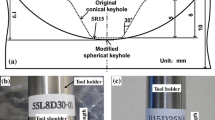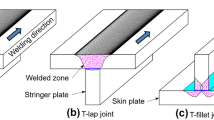Abstract
The groove shape of the weld faying part was investigated to obtain an ideal pipe friction-welded joint that had a fracture in the base metal and no inner flash of it. The steel pipe had inner and outer diameters of 8.0 mm and 13.5 mm, respectively, and the weld faying surface was of a basic flat shape (butt) type. Moreover, stepped and tapered groove shapes were prepared. Pipe groove shapes were welded with a friction speed of 27.5 s−1 and a friction load of 2.79 kN. Joining phenomena during the welding process were observed, and the tensile strength of joints was evaluated. The joints, that fabricated with flat or step groove shapes, made with a friction time at which the friction torque reached the initial peak did not have the tensile strength of the base metal nor a fracture in the base metal. However, the joints fabricated with a friction time that reached past the initial peak had a large flash, and they contained a fracture in the base metal. In contrast, when joints were made with a gently tapered groove shape with a friction time reaching the time of the initial peak, they achieved a fracture in the base metal, despite having an extremely small inner flash. Therefore, the shape at the weld faying part was capable of reducing the flash exhausted from the weld interface.















Similar content being viewed by others

References
Mitani K, Matsui S, Matsumura H et al (1992) Effect of high frequency preheating on plasma welding speed for SUS304 tube. Q J Jpn Weld Soc 10(2):223–228
Asai S (1999) Current trends of arc welding in plant piping. J Jpn Weld Soc 68(8):601–606
Teh LH, Rasmussen KJR (2007) Strength of arc-welded T-joints between equal width cold-formed RHS. J Const Steel Res 63(4):571–579
Wang KK (1975) Friction welding. Welding Res Counc Bull WRC Bull 204:1–21
Maalekian M (2007) Friction welding- critical assessment of literature. Sci Technol Weld Join 12(8):738–759
Eberhard BJ, Jr Schaaf BW, Wilson AD (1983) Friction weld ductility and toughness as influenced by inclusion morphology. Weld J 62(7):171s–178s
Kumar MV, Balasubramanian V (2014) Microstructure and tensile properties of friction welded SUS 304HCu austenitic stainless steel tubes. Int J Press Ves Pip 113:25–31
Ogawa K, Nakayama H, Ohue Y et al (1988) Fatigue strength characteristics of S35C/S35C friction welded tubular butt joints. J Soc Mater Sci Jpn 37(421):1209–1215
Palanivel R, Laubscher RF, Dinaharan I (2017) An investigation into the effect of friction welding parameters on tensile strength of titanium tubes by utilizing an empirical relationship. Measurement 98:77–91
Kawai G, Ogawa K, Tsujino R et al (1999) Statistical strength characteristics of aluminum alloy pipe and carbon steel pipe friction weld joints. J Jpn Soc Fract Strength Mater 33(1):1–10
Ohkubo Y, Iwamura S, Hatta H (2007) Thermal analysis on friction welding of carbon steel tube and AA5154 aluminum tube. Sumitomo Light Met Techn Rep 48(1):27–32
Balta B, Arici AA, Yilmaz M (2016) Optimization of process parameters for friction weld steel tube to forging joints. Mater Des 103:209–222
Michalski R (1989) Utilisation of welding flash friction. Mater Des 10(5):262–263
Palanivel R, Laubscher RF, Dinaharan I et al (2017) Microstructure and mechanical characterization of continuous drive friction welded grade 2 seamless titanium tubes at different rotational speeds. Int J Press Ves Pip 154:17–28
Luo J, Ye YH, Xu JJ et al (2009) A new mixed-integrated approach to control welded flashes forming process of damping-tube-gland in continuous drive friction welding. Mater Des 30:353–358
Rovere CAD, Ribeiro CR, Silva R et al (2014) Local mechanical properties of radial friction welded supermartensitic stainless steel pipes. Mater Des 56:423–427
Faes K, Dhooge A, de Baets P et al (2008) Influence of deceleration phase on properties of friction welded pipelines using intermediate ring. Sci Technol Weld Join 13(2):136–145
Pissanti DR, Scheid A, Kanan LF et al (2019) Pipeline girth friction welding of the UNS S32205 duplex stainless steel. Mater Des 162:198–209
Shi L, Song R, Tian X (2017) Plasma beam radius compensation-integrated torch path planning for CNC pipe hole cutting with welding groove. Int J Adv Manuf Technol 88(5/8):1971–1981
Li X, Ma H, Shen Z (2015) Research on explosive welding of aluminum alloy to steel with dovetail grooves. Mater Des 87:815–824
Wan L, Huang Y (2018) Friction welding of AA6061 to AISI 316L steel: characteristic analysis and novel design equipment. Int J Adv Manuf Technol 95(9/12):4117–4128
Ashfaq M, Sajja N, Rafi HK et al (2013) Improving strength of stainless steel/aluminum alloy friction welds by modifying faying surface design. J Mater Eng Perform 22(2):376–383
Kimura M, Ichihara A, Kusaka M et al (2012) Joint properties and their improvement of AISI 310S austenitic stainless steel thin walled circular pipe friction welded joint. Mater Des 38:38–46
Kimura M, Kusaka M, Kaizu K et al (2016) Friction welding technique and joint properties of thin-walled pipe friction welded joint between type 6063 aluminum alloy and AISI 304 austenitic stainless steel. Int J Adv Manuf Technol 82(1):489–499
Kimura M, Kusaka M, Seo K et al (2005) Effect of friction welding conditions and aging treatment on mechanical properties of A7075-T6 aluminium alloy friction joint. Sci Technol Weld Join 10(4):406–412
Kimura M, Kusaka M, Seo K et al (2004) Properties of low carbon steel joint by low heat input friction welding method. In: Proceedings of 57th assy of international institute of welding (IIW), Osaka, Japan, pp 139–149
Kimura M, Ohtsuka Y, Kusaka M et al (2005) Effect of friction time and friction pressure on tensile strength of welded joint for medium and high carbon steels by low heat input friction welding method. Q J Jpn Weld Soc 23(4):577–586
Saida K (2011) Principal of material joining and joining technology for metals. J Jpn Soc Prec Eng 77(3):273–277
Kimura M, Kusaka M, Seo K et al (2002) Effect of various conditions on friction torque in the first phase of friction welding. Q J Jpn Weld Soc 20(3):432–438
Kimura M, Kusaka M, Seo K et al (2005) Joining phenomena during friction stage of A7075-T6 aluminium alloy friction weld. Sci Technol Weld Join 10(3):378–383
Kimura M, Kusaka M, Seo K et al (2002) Relationship between the friction time, friction torque, and joint properties of friction welding for the low heat input friction welding method. Q J Jpn Weld Soc 20(4):559–565
Miyashita S, Takahashi M, Kimura M (2016) Deformation analysis of friction welding of heat- resistant steels. In: Proceedings of 10th international conference on trends in welding research and 9th international welding symposium of Japan Welding Society, Tokyo, Japan, pp 830–833
Acknowledgements
The authors wish to thank the staff members of the Machine and Workshop Engineering at the Graduate School of Engineering, University of Hyogo. We also wish to thank the alumnus Mr. Naoya Hashimoto at the University of Hyogo for his devoted contributions to this research project. Additionally, we wish to thank Mr. Shigekazu Miyashita from the Toshiba Energy Systems & Solutions Corporation for his kind and persisting assistance provided to this study.
Author information
Authors and Affiliations
Corresponding author
Rights and permissions
About this article
Cite this article
Kimura, M., Iwamoto, S., Kusaka, M. et al. Effect of weld faying part groove shape on reduction of inner flash in steel pipe joints fabricated by friction welding. Adv. Manuf. 7, 411–422 (2019). https://doi.org/10.1007/s40436-019-00274-1
Received:
Revised:
Accepted:
Published:
Issue Date:
DOI: https://doi.org/10.1007/s40436-019-00274-1



